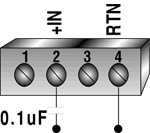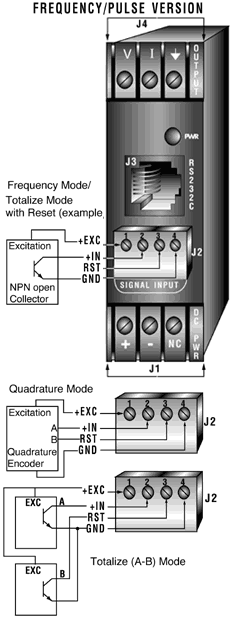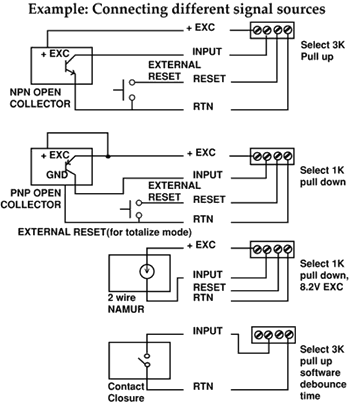|
The DRN Series of DIN rail-mountable signal conditioners are available for Thermocouple, RTD, Strain, Process, AC Voltage, AC Current and Pulse/Totalizer input types. The factory calibrated signal conditioners are ideal for all process and power monitoring applications, they feature 3-way isolation, high accuracy input, programmable outputs, and are excellent front end interfaces for programmable logic controllers or data acquisition systems. For maximum user configurability the signal conditioners allow complete input-output scaling via a RS-232 connection to any PC or PLC. Software Description The signal conditioner configuration program is a MS DOS/Windows program (this manual is for the Windows version). It is designed especially for the DRN Series Signal Conditioner. This program will run on any PC with Windows application and will start automatically.
Open Collector NPN (Use software to set: 3 Kohm pull up to 5V): Max. current source = 1.66 mA Open Collector PNP (Use software to set: 1Kohm pull down to RTN): Max. current sink = 12.5 mA TTL/CMOS Input: (Use software to set: no pull up/down). Low <= 0.8 V , High >= 3.5 V (For Input: 0.2 Hz to 16 KHz) Low <= 0.8 V , High >= 12 V ( For Input: 0.2 Hz to 50 KHz) NAMUR Sensors (Use software to set: 1Kohm pull down to RTN and 8.2V Excitation.) For measuring a low level signal riding on top of a large DC signal, connect a 0.1 uF capacitor. See Detail. Use software to set 1Kohm pull down to RTN. OPERATING MODES FREQUENCY Range = 0.2 Hz to 50 KHz Totalize with Reset Range = 0 to 999999, if reading is larger than 999999, then reading is converted to floating point number, i.e. 9.99E9 (maximum). A-B Totalize (Reset input used as +A input) Range = -99999 to 999999, if reading is larger than 999999, then reading is converted to floating point number, i.e. -9.99E9 (minimum), 9.99E9 (maximum). Quadrature (Reset input used as second input) Range = -99999 to 999999, if reading is larger than 999999, then reading is converted to floating point number, i.e. -9.99E9 (minimum), 9.99E9 (maximum).z INPUT IMPEDANCE Input: 1Mohm to +EXC Reset: 100K to +5V ISOLATION: Three way isolation up to 1800 V Peak for 1 minute, 354 V Peak continuous per IEC spacing. Normal mode rejection 60dB. Common mode rejection 100dB INPUT OVER-CURRENT PROTECTION With 1K pull down: 14V, With 3K pull up: 20V, Without pull up/down: 60V EXCITATION 5, 8.2 or 12.5V at 25mA, programmable ACCURACY AT 25 ░C ▒ 0.1% of Full scale Crystal time base accuracy: ▒ 50 ppm TEMPERATURE STABILITY ▒ 50 ppm/░C typical Time base stability: ▒ 1ppm/░C STEP RESPONSE FOR RS232 OUTPUT 0.1 second to 99% of the final value (Filter time constant = 0, Gate time = 0.05 Sec) RESPONSE TIME To verify the response time, check the carriage return <CR> Frequency mode response time is controlled by the gate time. If gate time is increased then response time is longer. Other modes response time is not controlled by the gate time. WARM UP TO RATED ACCURACY 30 minutes ANALOG OUTPUT SIGNAL TYPE Voltage 0-10 Volt, maximum current 10mA Current 0-20 mA or 4-20 mA, maximum compliance voltage 10 Volts (maximum loop resistance 500ohm) ANALOG OUTPUT LINEARITY 0.1% of FS ANALOG OUTPUT STEP RESPONSE TIME 2 seconds to 99% of final value INPUT POWER 10 to 32 Volt DC POWER CONSUMPTION 3 Watts (125mA at 24V DC) OPERATING AMBIENT -5 to +55 ░C STORAGE TEMPERATURE -40 to +85 ░C RELATIVE HUMIDITY 90% at 40 ░C non-condensing
INTRODUCTION The frequency/pulse signal conditioners are high performance instruments which operates in 4 different modes. Input can be programmed to read different signal sources including low level pulse, open collector and TTL/CMOS signals. Key features are: programmable excitation and input; operates as a rate meter, totalizer with reset, A-B totalize and Quadrature; scalable analog output and a simple RS232 interface for scaling analog output and range selection. The RS232 interface may also be used for digital transmission of the input signal to a computer or a PLC. Additional features include three way isolation between DC power, signal input and analog output/RS232. OPERATION Note: When connecting a pulse signal, ensure that the input signal voltage is less than or equal to the rating. The unit may be damaged if the input voltage exceeds the maximum rating. POWER INPUT and ANALOG OUTPUT SETUP
1. Connect a DC power supply with an output voltage between 10 to 32Volt DC to the signal conditioner (J1). Note: If power supply used has current limiting, it may not be able to power the signal conditioners if the available output voltage is around 10Volt, since the peak current may reach 1 to 5 Amps for a few milliseconds. 2. Ensure that if the selected mode or signal source is different from the default then change them using serial communication explained later in this manual. 3. Connect the signal input to screw terminal, and ensure that the screws are tight. 4. To view/change the scaling that relates the analog output to signal input: connect the RS232 output of the signal conditioner to an available serial port of a computer. The cable and the DB9 or DB25 connectors are available as an option. 5. Turn on the computer, start Windows 3.0 or higher and run the Signal Conditioner Configuration Setup Program. If the program has not been installed, then insert the 3.5ö floppy disk in either drive A or B. From the Program Manager choose File, Run; in the command box type either A: setup or B: setup according to your drive designation. The program will create an icon for the signal conditioner. You may start the program by clicking on this icon. 6. Start the configuration program, you need to indicate which serial port is to be used for serial communication by checking the appropriate check box on the opening menu. Note: It is not necessary to know the serial communication protocol. i.e. baud rate, parity, 7/8 data bit and stop bit; the program will determine this information automatically. However, it is good practice to mark the protocols used on the signal conditioner label if different from default. 7. Once the program starts it will automatically detect the signal conditioner configuration and will display a window of available options. To view the signal input click on the display on/off. 8. To change analog output scaling choose analog output scaling and enter the desired values. 9. Once the custom scaling is finished, ensure that Send Configuration is clicked, otherwise the changes will not take effect. 10. The input/output scaling may be fine tuned, while both communication and analog output are active. You may make a change to the analog output in the configuration program, and watch the DVM connected to analog output of the signal conditioner follow the new settings. 11. You may save or print a particular configuration by selecting the file menu. ItÆs always a good practice to both print and save the scaling of each signal conditioner. 12. If the program is not able to establish communication then an error message is displayed. This happens either when the wrong serial port is specified or when the cable is disconnected.
|





